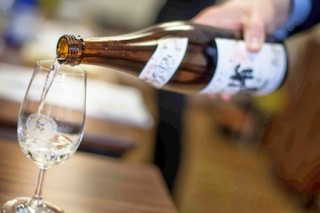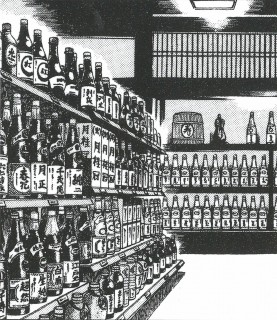 I enjoy sake. I don’t have the opportunity to drink it very often, and I don’t really know much about it, but I do enjoy it and have an interest in it. Fortunately, I recently had the opportunity to hear Natsuki Kikuya, the founder of Museum of Sake, give her presentation “World of Sake: How It’s Created, and Where It’s Going.” Kikuya is from a family of sake brewers which is part of a collective in the Tōhoku region of northern Honshū. She currently works with chefs in the United Kingdom as a sake sommelier and is in the process of developing a sake documentary; her personal mission is to introduce and promote sake across Europe and the rest of the world. The craft and culture surrounding sake and sake brewing is broad and deep. A comparison can easily be made with wine culture, but Kikuya has found that in the West a “translator” is often needed for sake. Whereas wine has an extensive vocabulary already established to describe it, traditionally sake has had only two descriptors: dry and sweet.
I enjoy sake. I don’t have the opportunity to drink it very often, and I don’t really know much about it, but I do enjoy it and have an interest in it. Fortunately, I recently had the opportunity to hear Natsuki Kikuya, the founder of Museum of Sake, give her presentation “World of Sake: How It’s Created, and Where It’s Going.” Kikuya is from a family of sake brewers which is part of a collective in the Tōhoku region of northern Honshū. She currently works with chefs in the United Kingdom as a sake sommelier and is in the process of developing a sake documentary; her personal mission is to introduce and promote sake across Europe and the rest of the world. The craft and culture surrounding sake and sake brewing is broad and deep. A comparison can easily be made with wine culture, but Kikuya has found that in the West a “translator” is often needed for sake. Whereas wine has an extensive vocabulary already established to describe it, traditionally sake has had only two descriptors: dry and sweet.
 So, what is sake? In Japanese, “sake” is a word that simply means “alcoholic beverage.” However, when the term is used in English, generally it is specifically referring to what is known in Japan as nihonshu. Sake is a fermented and filtered alcoholic beverage that is no more than 22% alcohol by volume. Typically, sake is brewed using only four ingredients: rice, water, yeast, and koji. Approximately 1% of Japan’s total rice production is devoted specifically to the brewing of sake. Though still edible, the rice used in sake is very different from table rice meant for consumption. When making sake the outside of the grains of rice is polished away, leaving behind the starches. In the highest quality sake, more than half of the rice is polished away. (In one exceptional case, only 7% of the rice remained after polishing.) Water is a particularly important ingredient as sake is made up of around 80% water. Water from different sources can significantly change the taste of the sake; generally water with softer qualities is desired. Up until the 20th century, sake production primarily relied on wild yeast, however more than 90% of sake fermentation now uses cultivated yeast. Koji is sake’s “magical ingredient”—a type of mold spore that transforms the starches in the rice into sugars for the yeast to ferment. Sake is often described as being “grown in breweries”; its quality very much depends on the human techniques involved and there is less emphasis placed on vintage as a result.
So, what is sake? In Japanese, “sake” is a word that simply means “alcoholic beverage.” However, when the term is used in English, generally it is specifically referring to what is known in Japan as nihonshu. Sake is a fermented and filtered alcoholic beverage that is no more than 22% alcohol by volume. Typically, sake is brewed using only four ingredients: rice, water, yeast, and koji. Approximately 1% of Japan’s total rice production is devoted specifically to the brewing of sake. Though still edible, the rice used in sake is very different from table rice meant for consumption. When making sake the outside of the grains of rice is polished away, leaving behind the starches. In the highest quality sake, more than half of the rice is polished away. (In one exceptional case, only 7% of the rice remained after polishing.) Water is a particularly important ingredient as sake is made up of around 80% water. Water from different sources can significantly change the taste of the sake; generally water with softer qualities is desired. Up until the 20th century, sake production primarily relied on wild yeast, however more than 90% of sake fermentation now uses cultivated yeast. Koji is sake’s “magical ingredient”—a type of mold spore that transforms the starches in the rice into sugars for the yeast to ferment. Sake is often described as being “grown in breweries”; its quality very much depends on the human techniques involved and there is less emphasis placed on vintage as a result.
During her talk, Kikuya outlined a brief history of sake and its development in Japan. Sake had its beginnings over 2,500 years ago, originating as the “drink of the gods” and was associated with Shinto shrines. Between the 7th and 12th centuries, sake came under control of the court. During that time there were thirteen different grades of sake appropriate for the different ranks of nobility. In the Middle Ages the center of sake production moved to Kōfuku-ji in Nara and other Buddhist temples. At this point in history distilled spirits from abroad began to be introduced to Japan as well. The Edo period saw the rise of brewing specialists and the center of sake production once again moved, this time to Itami and Edo. Previously sake had been made year-round, but as the brewing techniques were refined during the Edo period it became a winter-specific process. The Edo period also saw the establishment of izakaya and the culture of eating outside of the home; sake was no longer just for nobles. Homebrewing was prohibited in 1899, mostly for tax reasons, and so sake brewing became more of a corporate affair during the Meiji era.
The 20th century brought the “era of synthetic sake.” When rice was not readily available (during times of war, for example), techniques were developed to compensate for this lack, such as the introduction of syrups. The quality of the results were not always particularly good. And then there is sake industry today, which is focusing on modernization, localization, and globalization. This includes the creation of “new gen” sake, such as sparkling sake and sake with low alcohol content, as well as the use of sake in mixed drinks. At one point there were over 4,000 breweries in Japan. Sadly, the industry is dying and only around 1,200 breweries currently remain. Of those, the top twenty account for 80% of the sake production in Japan, however local breweries are beginning to gain increased support. There are several theories as to why interest in sake is declining in Japan: the continued Westernization of the country, the aging and shrinking of the population, and the fact that younger generations simply don’t seem to be drinking sake. Although the sake industry is still dominated by men, Kikuya knows of at least ten women heads of breweries. Interestingly enough, in addition to Japan, the United States is also a leading producer of sake and currently has seven to eight breweries of its own.
Prior to the Kikuya’s talk, my knowledge of sake had primarily been gleaned from what I myself had tasted as well as from manga like Tetsu Kariya and Akira Hanasaki’s Oishinbo (especially the volume Oishinbo, A la Carte: Sake) and Masayuki Ishikawa’s Moyasimon. I was quite happy to discover that those series have actually provided me with a fairly strong introduction to and basic understanding of sake and the sake industry, including some of the more unusual and interesting historical tidbits. So, even if you don’t have the chance to take advantage of the knowledge of a sake expert, picking up a copy of Oishinbo, A la Carte: Sake and following it up with a bit of Moyasimon (the manga or the anime) is not a bad place to start. (Toko Kawai’s short boys’ love series The Scent of Apple Blossoms also features a sake brewer, though I haven’t read it yet to be able to say how educational the manga might be.) For those interested in learning more about sake, Kikuya’s Museum of Sake is also worth a look, as is Discovery UK’s series Discovering Sake. And sometimes the best way to learn about something is to simply experience it for yourself. Have a taste!


[…] by Tetsu Kariya and Akira Hanasaki. In fact, just a few weeks ago I brought the series up in my random musings about sake. (Also, Oishinbo specifically and food manga in general were the subjects of May 2012′s Manga […]